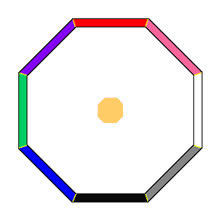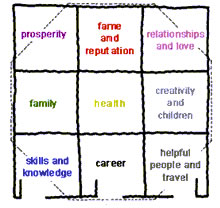The Bagua Octagon
The symbol that Feng Shui experts use in order to describe the entirety of our life experiences is called the Bagua. This special eight-sided figure is the geometric symbol of the Universe and the workings of nature’s laws. It presents the eight life energies, which serve as channels to attaining a fulfilling and blossoming life while acknowledging the uniqueness of each individual and allowing their potential to develop.
The eight trigrams that make up the Bagua may also be interpreted as having a changing or a static quality. There are four static or Yin trigrams in the Bagua. These trigrams have no direction, i.e. their meaning is the same whether you read them upwards or downwards. They are Chyan (heaven), Kwun (earth), Kan (water), and Li (fire).
The other four trigrams, or Gua, are most definitely defined by direction. They become different trigrams and their meaning changes when they are read in opposite directions. E.g. Syun becomes Dwei when reversed. Here are the changing or Yang Gua: Dwei (lake), Syun (wind), Jen (thunder), and Gen (mountain).
Traditional scholars thought that the Tai Chi direction – i.e. the centre of the Bagua – is fixed or unchangeable among the trigrams that emerge from it or radiate energy.
The Bagua of the Tantric Buddhism Black Hat Sect, which was designed by Prof Lin, has a completely different view of the Tai Chi. Here it is seen as a changing entity that moves constantly, due to an interlocking of Yin and Yang: it has no beginning and no end, no upper or lower parts. The Tai Chi is a non-directional unit.
Using the Bagua can help you learn how to bring harmony into your homes and your lives. This will help you define the essence of life and maintain its balance.
The Bagua octagon is a model for understanding the way in which chi manifests and moves in our homes.
Your physical existence is necessary in order to survive and learn about all that you need as a human being. But if you don’t make any progress by experiencing love, and if you don’t change the material aspects of your life into more spiritual matters, you’ll never be able to reach your spiritual self. These are energetic centres of transformation.
When you understand what you are made up of, you’ll be able to begin shaping yourself and decide which path to take. The old saying, “Knowledge is power” is true as can be. When you discover all of these energies or power-centres that define you, your environment, and the Universe, you’ll be able to use them in order to become a Creator and to live the kind of life that you were meant to live.
That the Bagua remains a valid and accessible tool thousands of years since it was originally created stands proof that the ancients understood the way in which Nature’s laws apply to human beings. The root of all the schools remains the same. Each of them leads us to a path of self-exploration and spiritual development.

Using the Bagua
For a better understanding of your path, you need to look deeply into the Bagua to find out what your living space is trying to tell you about your life. The Bagua becomes a working tool that you can use to identify, enhance, and modify the chi in any space, residence, workplace, patio or bedroom. When you change something in your house, in a specific area of the Bagua, try to bring positive changes in the respective area of your life.
The Bagua is a flexible tool that can be used at different levels. You can use it:
• at very large-scale level – over the entire building, including the patio and the land on which the house (or office, or condominium) is built;
• at large-scale level – over the (architectural drawings of) the entire house;
• at small-scale level – each room has its own Bagua;
• at very small-scale level – the Bagua can be superimposed over each piece of furniture.
If your space has an irregular shape or if a corner is missing, this can determine a loss of balance to the corresponding life energy. In other words, if one of the areas is missing, then your home – and probably your life – will lack balance. In most cases you’ll be able to feel the lack of balance. For some reason you’ll feel less comfortable, not quite “at home”. Or there will be some rooms where your guests won’t feel at ease. These are all signs of chi imbalance. You might think this is unimportant, especially if that room is a guest bedroom. “No matter,” you might say. “I never use that room.” But it matters a great deal! If a part of your space is out of sync, this means that a part of the whole is out of sync.
This knowledge will help you operate some changes that will lead to enhancing the chi of your home and of your body.
